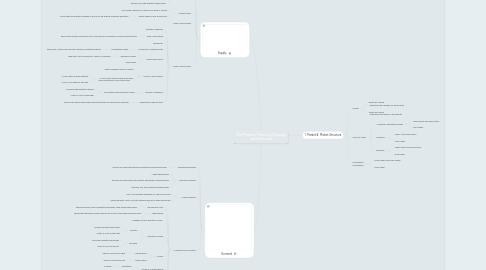
1. Demand
1.1. • Quantity demanded
1.1.1. Amount of a good that buyers are willing and able to purchase
1.2. The law of demand
1.2.1. – Other things equal
1.2.2. the price of a good rises, the quantity demanded of the good falls
1.2.3. the price falls, the quantity demanded rises
1.3. • Market demand
1.3.1. Sum of all individual demands for a good or service
1.3.2. Market demand curve: sum the individual demand curves horizontally
1.4. 3. Demand Curve Shifters
1.4.1. The demand curve
1.4.1.1. Shows how price affects quantity demanded, other things being equal
1.4.2. “other things”
1.4.2.1. Things that determine buyers’ demand for a good, other than the good’s price
1.4.3. • Changes in them shift the D curve…
1.4.4. Number of buyers
1.4.4.1. Increase
1.4.4.1.1. Increases quantity demanded
1.4.4.1.2. IShifts D curve to the right
1.4.4.2. Decrease
1.4.4.2.1. Decreases quantity demanded
1.4.4.2.2. Shifts D curve to the left
1.4.5. Income
1.4.5.1. Normal good
1.4.5.1.1. Shifts D curve to the right
1.4.5.2. Inferior good
1.4.5.2.1. Shifts D curve to the left
1.4.6. Prices of 2 related goods
1.4.6.1. substitutes
1.4.6.1.1. increase
1.4.6.2. complements
1.4.6.2.1. decrease
1.4.7. Tastes
1.4.7.1. a shift in tastes toward a good will increase demand for that good and shift its D curve to the right
1.4.8. • Expectations about the future
1.4.8.1. an increase in income, increase in current demand
1.4.8.2. higher prices, increase in current demand
2. Supply
2.1. • Quantity supplied
2.1.1. Amount of a good
2.1.2. Sellers are willing and able to sell
2.2. The law of supply
2.2.1. – Other things equal
2.2.2. the price of a good rises, the quantity supplied of the good rises
2.2.3. the price falls, the quantity supplied falls
2.3. • Market supply
2.3.1. Sum of the supplies of all sellers of a good or service
2.3.2. Market supply curve: horizontally
2.3.2.1. To find the total quantity supplied at any price, we add the individual quantities
2.4. Supply Curve Shifter
2.5. Supply Curve Shifter
2.5.1. Weather conditions
2.5.2. Ease of borrowing
2.5.2.1. Easy credit facilities makes the cost of borrowing or spending on credit more attractive
2.5.3. Technology
2.5.4. Production of related goods
2.5.4.1. Competitive supply
2.5.4.1.1. uses some of the same resources: termed, competitive supply
2.5.5. Government policy
2.5.5.1. changes in supply
2.5.5.1.1. lower the cost of production, supply is increased
2.5.5.2. Joint supply
2.5.6. Prices of factor inputs
2.5.6.1. Supply related to prices of inputs
2.5.6.2. – A fall in input prices makes production more profitable at each output price
2.5.6.2.1. • Firms supply a larger quantity
2.5.6.2.2. • The S curve shifts to the right
2.5.7. Number of suppliers
2.5.7.1. An increase in the number of sellers
2.5.7.1.1. • Increases the quantity supplied
2.5.7.1.2. • Shifts S curve to the right
2.5.8. • Expectations about future
2.5.8.1. Sellers may adjust supply when their expectations of future prices change
3. 1. Market & Market Structure
3.1. Market
3.1.1. Buyers as a group • Determine the demand for the product
3.1.2. Sellers as a group • Determine the supply of the product
3.2. The Four Types
3.2.1. • Perfectly competitive market
3.2.1.1. Many buyers and Many sellers
3.2.1.2. Price takers
3.2.2. Monopoly
3.2.2.1. Seller 1 and Many buyers
3.2.2.2. Price Maker
3.2.3. Oligopoly
3.2.3.1. Fewer sellers and Many buyers
3.2.3.2. Price Maker
3.3. Monopolistic Competition
3.3.1. Many buyers and Many sellers
3.3.2. Price Maker
